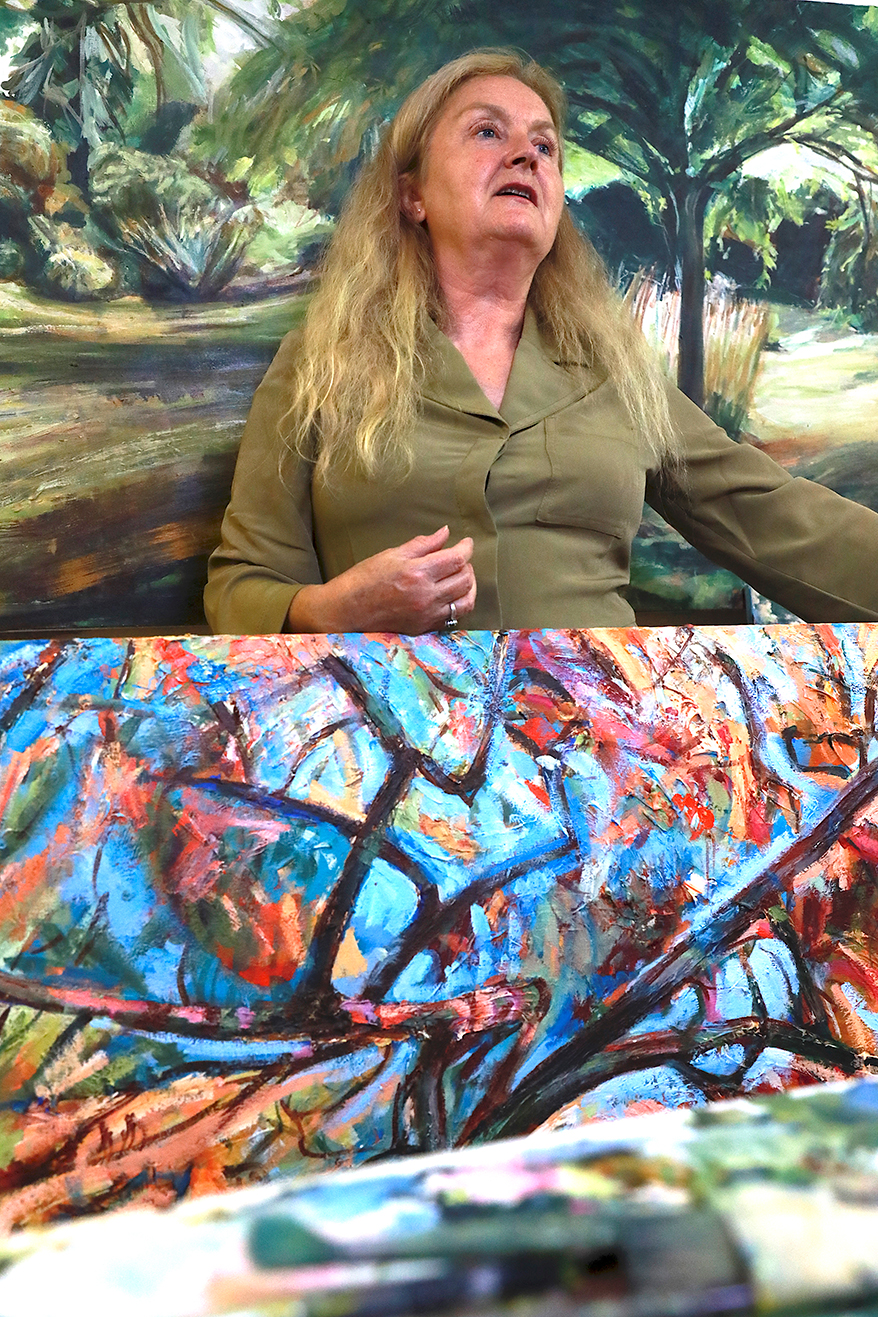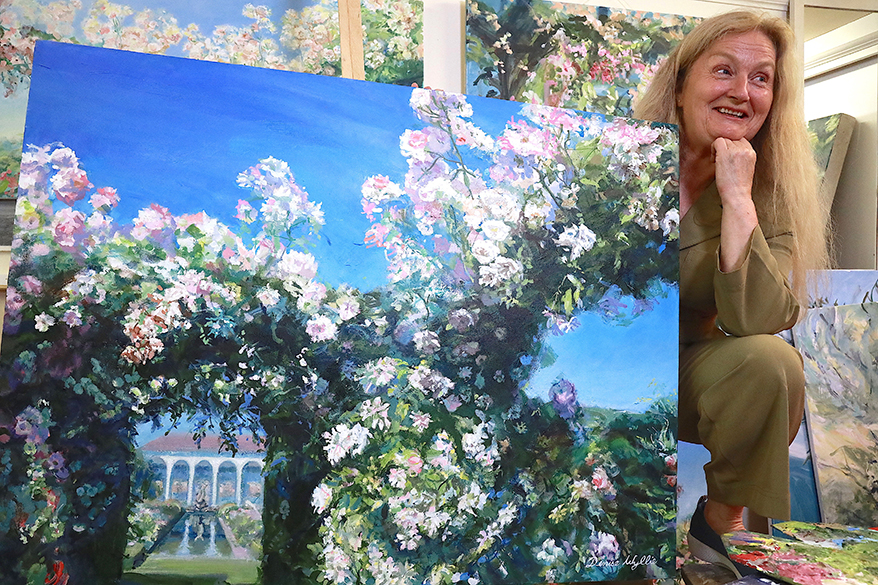THE ART WORLD has suddenly gone all cherry blossom. And why not? Damien Hirst has gone from pickling sharks and Swarovski crystal-studded skulls to painting blossoming flowers. And not to be outdone, David Hockney’s cherry blossom efforts have also been in the news as he swaps paint for an iPad to capture the blossoming magic of spring at his Normandy retreat. London artist Denise Ballard-Wyllie claims she was there first, painting them since she was a child. This passion was rechanneled during a residency at Myddleton House Gardens in Enfield, painting cherry blossoms and capturing the super-charged content of nature.
It was there she realized that if she were to do justice to her artistic expression, best make regular seasonal sojourns to Japan where it’s the national flower of Japan, celebrated for centuries and a symbol of life, death, and renewal. Her painting and printmaking processes allow the kinds of visual statements in landscapes that draw comparisons with Japanese work but with her own original themes and expression.
In Japan the flower is so revered and protected that it is illegal to pick it and its fleeting, but meaningful lifespan has inspired many works of art. The blossom dies two weeks after full bloom and has inspired the Japanese tradition of hanami – the observance of this transience and seasonal renewal.
Ballard-Wyllie pays homage to Japanese art in her own work. This can clearly be seen in pieces such as her Cherry Blossom Front series: Fresh Spring Morning, Languid Spring Afternoon, the Effervescences of Summer recently exhibited at the Bankside Gallery. This influence is inevitable given her time spent there drawing from source, studying from nature and working from the studios of Japanese masters. This laid the foundation for the later screen prints of flowering cherry blossom. Her tree portraits capture the same landscapes at different times each season, and with every new screen print there’s another thematic nuance and mood.
And she’s not jumping on the Hirst-Hockney bandwagon. Indeed, the great Japanese artists were there first and she’s the first to admit their preeminence; the masterful brushwork and woodblock prints of the likes of Katsushika Hokusai, Japan’s greatest artist, have left their mark on European art since the rediscovery of his Edo period masterpieces in the late 1800s. The Japanese influence since then is such that even Vincent van Gogh’s Almond Blossom (1890) was influenced by Japanese art.
Hokusai’s classic works featuring Mount Fuji and flowering cherry blossom exemplify the Japanese tradition around the celebration of the transient yet re-energizing elements of spring. There’s an autumn exhibition of his work at the British Museum, Hokusai: The Great Picture Book of Everything, Sept. 30, 2021 through January 2022. Ballard-Wyllie also acknowledges the importance of landscape works of European masters such as Monet.
Advertisement
So, she does not feel she is playing catch up with Hirst the middle-aged YBA (Young British Artists who came to prominence in the late 1980s). Some who have seen his cherry blossom work at the Foundation, Cartier, Paris claim his switch to flower painting is fueled by creative restlessness and tinged with kitsch and irony, and even he says (tongue firmly in cheek) that he is only doing it because his mum asked him to paint something “nice” for a change. Apparently, she prefers “nice” flowers to cold, clinical, sculptural pieces and has probably endured his celebration of the macabre since his earliest forays into art when as a teenager he photographed himself at a morgue with a corpse head, grinning triumphantly (he, not the corpse!).

Ballard-Wyllie makes many drawings onto translucent drafting film and transfers the drawings to a silkscreen. She does this by coating, drying, and exposing a light sensitive emulsion to UV light but using her drawings as a mask and a way of stopping the light get onto all of the screen. When she washes the exposed screen the areas protected from the hardening effect of the UV light are washed away, leaving a space where she can print through the screen.
She prints through the screen by flooding the screen with a previously prepared liquid ink and pushes the ink through the fine mesh of the screen onto the paper underneath. The screen is locked into place onto the screen bed table and the paper is held in the precise place (in register) by card ‘stops’ and a vacuum that sucks the paper to the screen bed. It is possible to use a primitive kitchen table to screen print on, but a professional screen bed is far preferable, especially if you are printing many colors, like she does, or big editions that must be perfectly registered.
She makes many variations of one theme. These are often very small editions or 10, lots of one offs/mono prints along with one, big edition of 20 to 50 or more. She hand printed this artwork series at (the now defunct) London Print Studios in West London. She used a large Kippax screen bed. Now the studio has shut down, she has to rethink her working space and consider a low-tech set-up in her home garden studio or locate at a new artists print studio.
If you’re curious about these different expressive depictions and technical approaches to cherry blossom and want to see Ballard-Wyllie’s in juxtaposition with the Hirst and Hockney exhibitions, you can see her work at several exhibitions this year.
Advertisement
Her cherry blossom work returns to Japan in November 2021 where it will be exhibited at the Awagami Miniature Print Exhibition AIMPE 2021. The selected work, Judge Penny’s White Cherry Tree, created on white Japanese washi bamboo paper, will be exhibited in two spaces – the Awagami Hall of Awa Japanese Handmade Paper Museum and Awagame’s neighboring post-industrial gallery Inbe Art Space.
If you are looking for her London shows, a selection of her cherry blossom work has already been shown at the Bankside Gallery, London and continues there from summer to early autumn. The RE Original Prints’ exhibition ran from May through June and featured her Cherry Blossom Front: Winter Introspection and Into the Renaissance Garden landscapes. The Bankside Summer exhibition runs from July through August and features two of her works: Cherry Blossom Front Effervescences of Summer and Long Summer Garden, and her work will also be shown at their September showcase.


 Art, Ad, or Alchemy1 month ago
Art, Ad, or Alchemy1 month ago
 Case Studies1 month ago
Case Studies1 month ago
 Andy MacDougall1 month ago
Andy MacDougall1 month ago
 Editor's Note1 week ago
Editor's Note1 week ago
 Columns2 weeks ago
Columns2 weeks ago
 Thomas Trimingham2 months ago
Thomas Trimingham2 months ago
 Marshall Atkinson1 week ago
Marshall Atkinson1 week ago
 News & Trends1 month ago
News & Trends1 month ago










